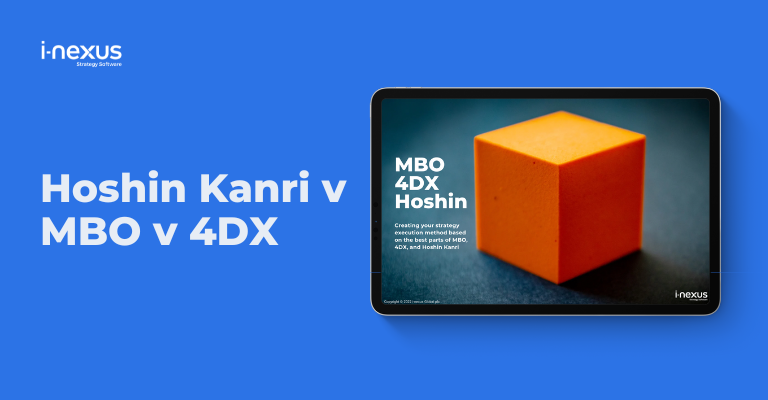With so many resources to support your deployment of Hoshin Kanri in 2022, it's hard to know which you truly need to consider. Here are our top 6 recommendations for all things Hoshin Kanri.
Written by: James Milsom, Head of Marketing
Hoshin Kanri is a powerful way to ensure your Strategy Execution is on track and performing well. When implemented properly, it bridges the gap between your developed strategy and its execution, resulting in organization-wide alignment and focus.
But achieving that is easier said than done. Only 56% of strategies succeed and the majority fail because of poor implementation. Aligning your strategy deployment with your business model is critical. Organizations that report poor alignment additionally suffer from weaker financial results.
A planning and deployment method can be a key element in transforming your once struggling strategic performance. And, in many ways, Hoshin Kanri can resolve the underlying issues that cause your, and countless others' strategies to stutter in the first place.
To start, you must understand the basics of Hoshin Kanri's methodology. Additionally, there are added benefits in understanding how Hoshin interacts with Plan Do Check Act (PDCA), Management by Objectives (MBO), and the Balanced Scorecard (BSC).
Here are the top resources to help you succeed with Hoshin Kanri.
Understanding the Hoshin planning system
The most logical resource, to begin with, is one that answers the question "what is Hoshin Kanri?".
Hoshin planning gives you a process for aligning goals at all levels of your company with your wider strategic vision.
It helps to communicate your strategy to everyone in your organization and demonstrate the connectivity of their work on the overall strategy.
This requires a few steps, including:
- Defining the objectives you want to achieve as an organization
- Breaking this down into sub-goals and cascading throughout the company
- Communicating these goals and driving engagement through a systematic approach such as catchball
- Developing a governance system to track performance.
Unpicking The X Matrix
The Hoshin Kanri X-Matrix (also known as the Hoshin Planning Matrix) helps organizations to capture strategic objectives, cascade priorities, and assign ownership.
Its name comes from the X that divides the matrix into four key areas:
- Long-term goals (South)
- Annual objectives (West)
- Top-level priorities (North)
- Metrics to improve (East)
The x-matrix and its use are best described visually.
This video resource gives an easy-to-understand introduction to the matrix and Hoshin Planning as a whole:
Hoshin Kanri’s origins: Management by Objectives
It pays to know some of the key influences on Hoshin Kanri’s development. One of which was Peter Drucker’s Management by Objectives (MBO).
The MBO approach seeks to align employees’ objectives with the organization’s goals, involving every company level, from the c-suite to the shop floor.
The process is laid out with this diagram from Expert Programme Management:

For an introduction to Management of Objectives, Investopedia offers a good introduction to the basics and principles of the methodology and MBO in practice, or read a copy of our Hoshin Kanri v MBO v 4DX eBook.
Plan-Do-Check-Act
Another influence on Hoshin Kanri is Deming's Plan-Do-Check-Act approach which continuously improves performance.
It involves systematically testing processes, assessing the results, and then implementing the solutions with the best returns.
It’s also known as the Deming Cycle, and the Balanced Scorecard Institute provides a useful explainer article.
Balanced Scorecard
The Balanced Scorecard (BSC) is often used alongside Hoshin Kanri to improve strategy execution and manage a long-term strategy.
The benefits of combining both approaches are discussed in several academic reports, including:
Balanced scorecard and hoshin kanri: dynamic capabilities for managing strategic fit
Witcher and Chau's 2007 paper examines the combination of the BSC and Hoshin Kanri.
The first paper of its kind, it's a seminal read into how the two methodologies can complement each other in strategy execution.
A valuable Hoshin resource to consume, it reveals how the combination is a useful framework for managing sustained competitive advantage for organizations.
To understand more about the Balanced Scorecard, the Balanced Scorecard Institute is a one-stop resource.
Going further with Hoshin Kanri
Hoshin Kanri can be tough to understand when approaching it for the first time.
There are plenty of online resources available, as well as discussions and books.
Hoshin Kanri for the Lean Enterprise is a fantastic book for an overarching look at Hoshin Kanri and its applications.
We would also recommend visiting our Hoshin Kanri resource center, which includes a wealth of Hoshin-related content, including:
- Hoshin Kanri eBooks
- Hoshin Kanri Plan Health Checklist
- Hoshin Kanri v OKR v OGSM eBook
- What is Hoshin Kanri PDF Guide
- 30+ Hoshin terms defined in the Ultimate Jargon Buster
- Hoshin Kanri vs. other strategic methodologies
- Excel templates for Hoshin planning
- Hoshin Kari Case Studies
- A Hoshin maturity calculator
Click here to visit the resource center.
Learn more about Hoshin Kanri, MBO, and other strategy execution methodologies, tools, and principles.
Take your pick from the resources below:
- OKR v OGSM v Hoshin: Find out the role that your approach to strategy execution has on your ability to deliver mission-critical goals in this eBook.
- How to accelerate strategy delivery: Flexibility is the new normal for your organization, that’s why we’re sharing 5 actions Heads of Strategy and Transformation can take to accelerate strategy delivery, all via an Agile mindset.
- Is there a better way to execute your strategy?: Watch this webinar as we share how organizations like yours are using i-nexus to close their strategy-to-execution gaps.
About the author
James Milsom is Head of Marketing. James has wide-ranging experience in markets such as telecommunications, energy, education, and software.
As Head of Marketing, he aims to raise awareness and understanding of enterprises' challenges in delivering strategic objectives and transformation amidst changing markets and the obstacles traditional tools and methods present leaders.
If you’d like to talk more about strategy execution, reach out to James at james.milsom@i-nexus.com or connect with him on LinkedIn for the latest insights.




